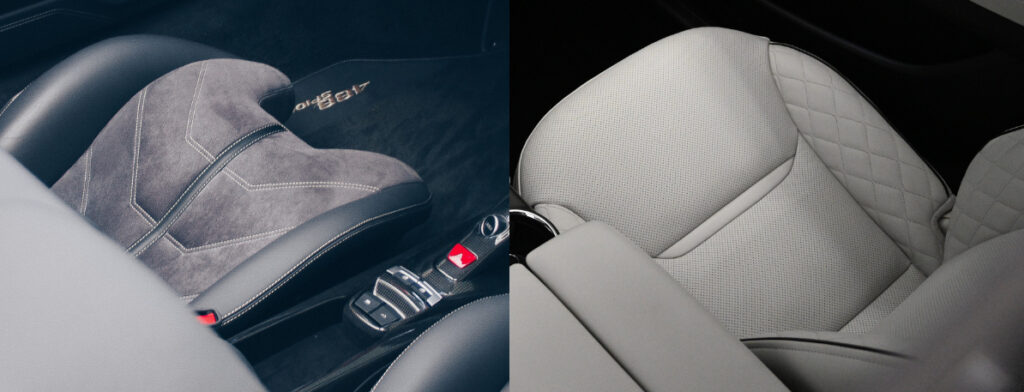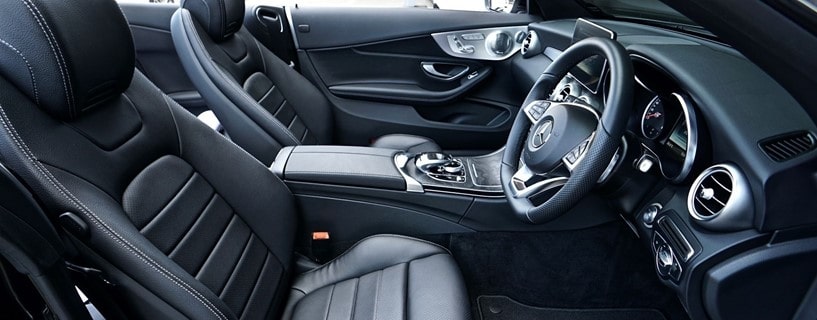Leather interiors have been a staple in high-end cars for decades but alcantara is becoming increasingly popular and is frequently used on the steering wheels, seats and dashboards of premium vehicles, but which is the best type of material?
In this article I’ll compare all the pros and cons of leather and alcantara including the ease of cleaning, durability, and the differences in texture so you can decide which is the best choice for your new car.
The Quick Answer
Leather is durable and easier to clean compared to Alcantara for car interior surfaces such as seats, dashboards and steering wheels. Alcantara is suitable for vegans unlike leather, and offers more grip. Leather interiors are more common whereas Alcantara is typically only used in high-end cars.
| Leather Interior | Alcantara Interior |
| Easier to wipe down | Requires more cleaning and care |
| More durable | Shows age after 10,000 miles |
| Gets hot in the sun | Does not get hot in the sun |
| Unsuitable for vegans | Suitable for vegans |
| Used by most brands | Used by high-end brands |
| Less expensive | More expensive ($2000+ option) |

Leather Car Interiors
Leather has been widely used on the seats, steering wheels and dashboards of cars by many brands for decades. It is a staple in most high-end cars and is an optional upgrade with many mid-range car brands as it offers a more premium look and feel compared to cloth and faux leather textiles. Although leather is a natural material, the leather used in car interiors has a synthetic clear coating over it to help protect it and make it easier to clean.
Here are the main advantages of leather interiors:
- Leather interiors are very durable.
- The leather can be easily cleaned and spills are less likely to get soaked up and stain the surface.
- Leather interiors are not overly expensive and are widely available.
Here are the main disadvantages of leather interiors:
- Leather gets very hot in the sun and can feel very cold in the winter.
- The leather looks shiny and greasy when it gets dirty and requires regular cleaning.
- Leather can crack and fade over time if not properly maintained.
- Not suitable for vegans.

Alcantara Car Interiors
First thing’s first, alcantara and suede are not the same thing. Alcantara is a synthetic textile which has been around since the 1970s and has been a popular choice in race car interiors for many years. In commercial vehicles, alcantara is not quite as widely seen and is typically reserved for very high end vehicles.
Alcantara is made of microfiber with a typical blend of 68% polyester and 32% polurethane giving it a very soft feel. It is mostly used on steering wheels and seats but can also been used on dashboards as well.
Here are the main advantages of alcantara:
- It has a grippy but still soft texture. This means it feels comfortable but also increases friction so the driver has a good grip of the steering wheel and doesn’t slide around in the seat too much.
- Since it is a synthetic textile, alcantara is a good choice for vegans.
- The temperature of alcantara is not heavily influenced by the environment, hence it will not get too hot in the sun or too cold in winter.
- When used on the dashboard it does not cast distracting reflections in the windscreen.
Here are the main disadvantages of alcantara:
- Alcantara is not a very durable surface since friction will cause the microfibers to wear away so the interior looks more worn out.
- It is an expensive option which typically costs upwards of $1500 (or £1000) on most cars.
- Requires regular cleaning to keep it in good condition.

Direct Comparisons
Now that we’ve been through an overview of each material, let’s directly compare them in the following categories:
- Ease of cleaning
- Durability
- Temperature resistance
- Suitability for Vegans
- Look and Feel
- Cost and Availability
Ease of Cleaning
Leather and alcantara car interiors both require regular cleaning and maintenance to keep them in good condition. Both surfaces require either a dedicated leather or alcantara cleaner which should ideally be worked in gently using a soft brush and wiped away using a microfiber cloth.
With leather interiors, a sealant should be applied to help keep it clean and protected. Since the leather has a synthetic clear coat over the top, a leather conditioner is not required unless the leather is aged.
Check out my complete guide to caring for car interior leather to learn everything you need to know.
Alcantara can also be protected using a specialist waterproofing spray which will help to protect it from spills and subsequent staining. If the fibres have become very flattened, then a vacuum with a crevice attachment can be hovered over the surface (without touching it) to fluff them back up a bit.
The cleaning products required for both surfaces are similarly priced.
In my opinion, leather is an easier surface to maintain because it can be simply wiped down with a leather cleaner to get it looking new again, whilst alcantara requires some extra time, care and stages to keep it looking fresh.
Winner: Leather
Durability
Leather is a more durable surface than alcantara for car interior surfaces such as the steering wheel and seats. Alcantara wears more quickly as the fibres are susceptible to friction which is why many brands use a combination of leather and alcantara on seats, and use leather on the seat bolsters which are more prone to friction damage when sliding in and out of the car.
Leather can still become worn though, especially if not looked after by neglecting to use a protection cream. Worn leather can fade and crack, but is easier to repair than alcantara.
If you do a lot of mileage and plan on keeping your car for many years, then leather is probably the better option.
Winner: Leather
Temperature Resistance
One main advantage that alcantara has over leather is that it does not get very hot in the sun. If you’ve ever parked a car with leather seats in the sun, you’ll know that it gets burning hot very quickly. Alcantara also has the edge in winter as well, as it doesn’t feel as cold when the temperature drops compared to leather. This can make early morning starts a bit more pleasant!
This isn’t much of an issue though if the car has a heated/ cooled steering wheel and seats, which many premium brands who offer alcantara interiors will also offer as an option extra.
Winner: Alcantara
Suitability for Vegans
Leather is a natural substance which comes from cowhide, making it unsuitable for vegans. Alcantara on the other hand is a synthetic textile which makes it a great choice for vegans who want a premium feeling interior.
The other option is to go for faux-leather, however this does not feel as nice and is typically only available in cheaper cars where alcantara isn’t even an option. So chances are that it’s either leather or alcantara that’s you’ll need to choose from if you’re looking at a high-end car.
Winner: Alcantara
Look and Feel
Many people see alcantara as a more luxurious material compared to leather, which is only cemented by the fact it’s an optional extra in exclusively high-end cars. Leather is more widely available and hence isn’t seen to be quite as premium by some people. It’s all personal preference though.
One noticeable difference between the two materials is the friction co-efficient. Alcantara has a higher friction co-efficient which means it feels more grippy in comparison to leather. It’s why alcantara is a popular choice for race car interiors because it means you won’t slide about in the seat as much. The same goes for it’s use on steering wheels.
Additionally, alcantara doesn’t create any reflections on the windscreen when used on the dashboard compared to leather. However, most won’t notice this and it certainly isn’t a glaringly obvious issue with leather dashboards.
Winner: Alcantara
alcantara creates more friction

Cost and Availability
Leather interiors are less expensive and more readily available than alcantara interiors. With most brands, the highest trim level (sometimes lower) will feature leather seats. However alcantara is typically only used on very premium cars and is often an optional extra which can cost $1500-$3000 (or £1000-£2000). Sometimes you’ll see it on mid-range cars but usually this is quite rare and only seen on special edition models.
Here is a list of some car brands which offer alcantara interiors:
- Volkswagen
- Audi
- Mercedes-Benz
- BMW
- Lexus
- Mazda
- Nissan
- Rolls Royce
- Bentley
- Maserati
- Ferrari
- McLaren
- Lamborghini
- Porsche (they use their own version called Race-Tex)

